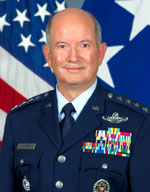
SLD sat down with General Duncan J. McNabb, Commander U.S. Transportation Command (USTRANSCOM), and his staff to discuss the role of TRANSCOM in current operations, with a special emphasis on Afghanistan and Haiti. This part of the interview focuses upon TRANSCOM and its operational approach. For those of us old enough to remember when there was not a TRANSCOM, we tend to think of the Air Mobility Command. We tend to focus on the airlift component for military supply. As such, our understanding is really limited concerning how TRANSCOM really executes the joint mission and balances its capabilities to deliver goods and troops to the globally deployed warfighter.
In this interview, General McNabb explains the TRANSCOM approach and highlighted three overall points:
- First, TRANSCOM is the Distribution Process Owner, or DPO, and has authority over the end-to-end delivery of kit and personnel. As such it is evolving data collecting techniques, shaping metrics and enhancing its ability to fuse data to understand options in delivering the capability to the warfighter. Transparency of data is a key requirement for full mission success.
- Second, TRANSCOM emphasizes multi-modal operations and processes, selecting the right mode(s) of transportation to meet warfighter needs. The task is to balance efficiency and effectiveness. The command focuses on using commercial partners, military airlift, ground delivery or sealift options and looks for the optimal combination to deliver kit and personnel.
- Third, in determining options, TRANSCOM works trade-offs among prioritization and speed of delivery, cost of delivery options, and security of supply.
This triangle, in effect, is how choice is determined (the first graphic in the slide show below was produced by SLD to illustrate the TRANSCOM Con-ops)
[slidepress gallery=’general-mcnabb-on-the-transcom-approach’]
SLD: How would you describe the overall role of TRANSCOM for the joint forces?
General McNabb: We are the Distribution Process Owner, or DPA, for transportation for the joint forces. We exercise the enterprise for end-to-end delivery options to the warfighter. And we are evolving our approach over time, for we have eight years of lessons learned: this evolving concept of operations is a marriage of technology and organization in working with military and commercial assets to deliver goods and troops to the deployed warfighter.
SLD: You describe TRANSCOM as operating as having a multi-modal emphasis. What do you mean by this?
General McNabb: We manage the operation of those assets to deliver capability to the warfighter. As such, we use the military airlift and sealift available to us as well as work with our commercial air and sea transportation partners. We are looking for cost effective ways to deliver capability. Obviously, the priority is important as well. If it is time urgent, we will use air. If it is less time urgent, we rely on other assets. But in general we deliver about 90% of our equipment by surface modes and 10% by air. In Afghanistan, based on the threat, we deliver approximately 80% by surface and 20% by air.
SLD: What is the impact of TRANSCOM on overall US global presence?
General McNabb: We have responded to 50 major events since 1990. Nearly 2/3rds of these are for disaster or humanitarian relief. In many ways, we are the focal point for the blending of soft and hard power; we facilitate both. The existence and operation of TRANSCOM is unique and gives an asymmetric advantage for our nation and allows us to support our allies as well. At any point in time, our components execute missions to provide 35 ships loading under way or offloading, and more than 900 sorties each day.
SLD: What is the major effort by TRANSCOM on process improvements and approaches?
General McNabb: Asset visibility is the cornerstone of effective end-to-end delivery. We are working to enhance such visibility. Indeed, we are standing up a new fusion center, which will allow us to have real-time visibility on assets and to make better decisions that support the warfighter. TRANSCOM has and will always, always deliver.
SLD: TRANSCOM faces an ever-changing demand structure. How does it manage flexibility to adjust to changing demand?
General McNabb: We have several flexible tools, including the Transportation Working Capital Fund, a flexible acquisition system, in house commercial, and international legal expertise to facilitate contracting, a foreign policy advisory unit among other things. We have a flexible set of management tools, which allow us to adjust to the challenges. Taken together, these logistics tools give our nation an asymmetric advantage over any adversary.
SLD: Having an end-to-end management system would seem to allow you to squeeze out savings in operations through gaining an ability to make strategic choices over how best to ship specific assets?
General McNabb: Our analyses show that we are in effect supporting a brigade combat team by the savings we squeeze out from improved operations each year. In numerical terms, we save about $500 million a year and are working on further improvements across the Joint Deployment Distribution Enterprise (JDDE) with our other JDDE partners.
SLD: There has been criticism of the inability to deliver M-ATVS on a timely basis. What is the source of the problem?
General McNabb: We were tasked to deliver 500 M-ATVs per month. We have been on line and poised to do so since November. We are now delivering 500 M-ATVs this month with a combination of air and surface assets.
———-
***Posted on May 21st, 2010


